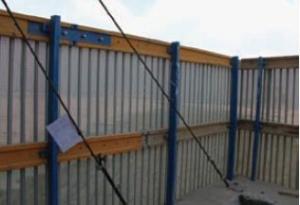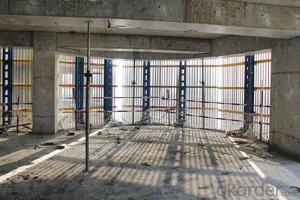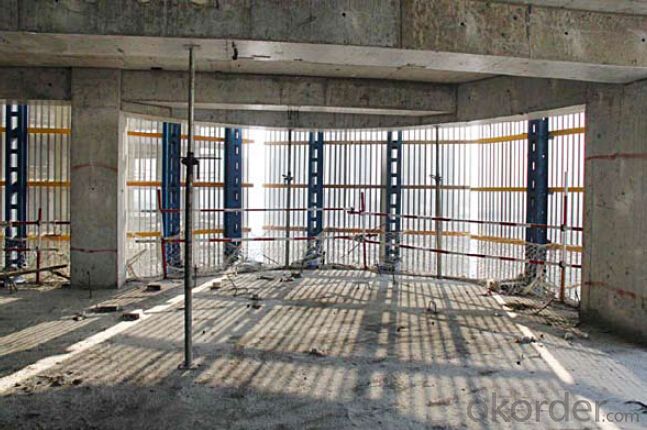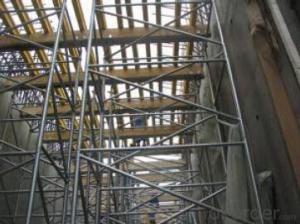Protection Platform for Formwork and Scaffolding System
- Loading Port:
- Tianjin
- Payment Terms:
- TT OR LC
- Min Order Qty:
- 50 m²
- Supply Capability:
- 1000 m²/month
OKorder Service Pledge
OKorder Financial Service
You Might Also Like
Protection Platform PP-50
A kind of new type construction protection system, applying operating platform and safer job
location for construction corps.
Characteristics:
◆ Easy and quick assembling.
◆ Lifted as a group, it is rapid and economic.
◆ Auto-climbing
◆ A safe and reliable anchor system
1. Composition
2. Assembly process of anchor system
(1) Embed V-climbing cone and anchor plate into the slab.
(2) Fix anchor shoe on the slab by tensile bolt.
(3) The fixed anchor shoe.
◆ High work efficiency with work platform and unload platform
◆ High light transmittance with the hollow block
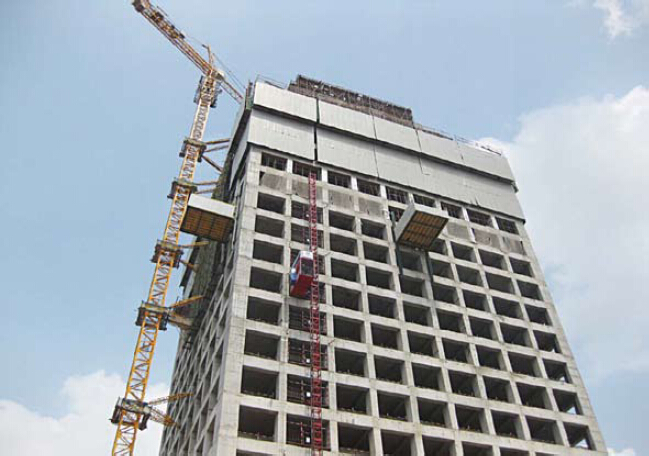
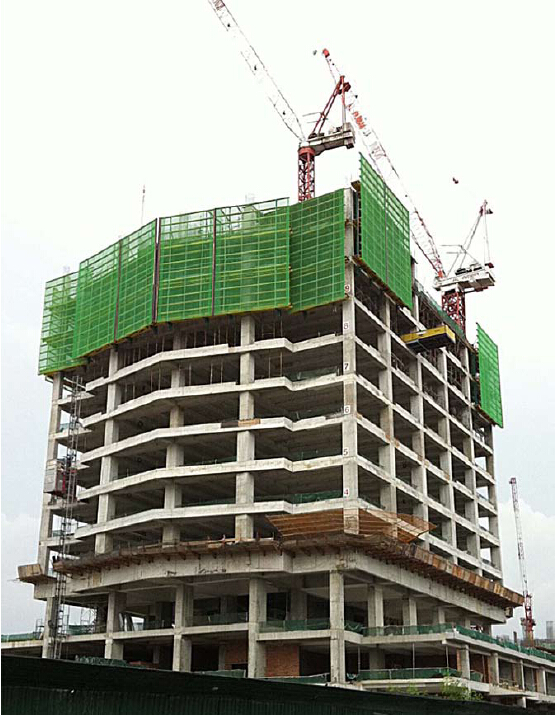
- Q: What are the advantages and disadvantages of the application of the steel formwork and the plywood formwork in the construction?
- From the aspect of Construction: the construction speed of the large steel formwork is fast, the quality effect is good; the wood formwork is assembled slowly, and the bulging phenomenon is easy to occur;
- Q: Can steel formwork be used for both horizontal and vertical construction elements?
- Yes, steel formwork can be used for both horizontal and vertical construction elements. Steel formwork is a versatile and durable option for creating concrete structures. It can be easily adjusted and assembled to accommodate various shapes and sizes, making it suitable for both horizontal elements like slabs and beams, as well as vertical elements like walls and columns. Steel formwork provides excellent support and stability during the concrete pouring process, ensuring the desired shape and finish of the construction elements. Additionally, steel formwork can be reused multiple times, making it a cost-effective choice for construction projects.
- Q: Does steel formwork require any special tools for installation and removal?
- Typically, special tools are needed for both installation and removal of steel formwork. This is because steel formwork is heavy and rigid, which often means cranes, forklifts, or other lifting equipment are necessary to position the formwork panels. Additionally, tools like spanners, hammers, and wedges are commonly used to secure the formwork panels tightly and ensure stability during concrete pouring. When it comes to removal, power tools like grinders or cutting torches are usually required to disassemble and separate the formwork from the hardened concrete. These tools are needed to cut through any welds or bolts that hold the formwork in place. It is important to be cautious and follow safety protocols while using these tools. In summary, the heavy and sturdy nature of steel formwork necessitates the use of special tools and equipment for both installation and removal. This ensures that the formwork process is carried out efficiently and safely.
- Q: Can steel formwork be used for architectural concrete beams?
- Yes, steel formwork can be used for architectural concrete beams. Steel formwork offers several advantages over traditional wooden formwork, such as increased durability and reusability. Steel formwork is stronger and more rigid, allowing for precise and accurate construction of architectural concrete beams. It also provides a smooth and consistent surface finish, which is important for achieving the desired aesthetic appearance of the beams. Additionally, steel formwork can be easily assembled, disassembled, and transported, making it a practical choice for architectural concrete beam construction.
- Q: How does steel formwork contribute to the overall cost-effectiveness of the construction process?
- Steel formwork contributes to the overall cost-effectiveness of the construction process in several ways. Firstly, steel formwork is highly durable and can be reused multiple times, reducing the need for frequent replacements and lowering the overall material costs. This durability also leads to reduced maintenance and repair expenses, further enhancing the cost-effectiveness. Secondly, steel formwork offers excellent dimensional stability, ensuring that the concrete structures are built with precision and accuracy. This results in reduced wastage of materials, as the formwork provides a reliable template for the desired shape and size of the concrete elements. Minimizing material wastage directly contributes to cost savings. Moreover, steel formwork provides faster construction cycles due to its ease of assembly and disassembly. The interlocking panels and adjustable features make it quick and efficient to set up, saving valuable time and labor costs. The seamless integration of steel formwork with modern construction techniques, such as mechanized systems, further enhances productivity and reduces construction time. Furthermore, steel formwork offers flexibility and adaptability, allowing for customization and adjustments as per project requirements. It can be easily modified to accommodate changes in design or specifications, reducing the need for additional formwork or costly modifications. This adaptability enhances cost-effectiveness by avoiding unnecessary expenses. Additionally, steel formwork is known for its high strength and load-bearing capacity, enabling it to withstand heavy loads and provide a safe working environment. This strength eliminates the need for additional support structures, reducing the overall material and labor costs. Overall, the use of steel formwork in the construction process contributes to cost-effectiveness through its durability, reduced material wastage, faster construction cycles, flexibility, and strength. By optimizing resources and enhancing efficiency, steel formwork helps to minimize expenses, making it a cost-effective choice in construction projects.
- Q: Can steel formwork be used for industrial structures?
- Yes, steel formwork can be used for industrial structures. Steel is a strong and durable material that can withstand heavy loads and provide excellent support for large-scale construction projects. It is often preferred for industrial structures due to its high strength-to-weight ratio, resistance to fire and corrosion, and ability to be reused multiple times. Steel formwork systems offer flexibility, cost-effectiveness, and efficiency in constructing various types of industrial structures such as factories, warehouses, power plants, and refineries.
- Q: How does steel formwork handle construction joints?
- Steel formwork is a versatile and durable option for handling construction joints. It is specifically designed to handle the demands of construction joints and ensure a seamless and efficient construction process. Firstly, steel formwork is known for its strength and stability, which allows it to withstand the pressure and weight exerted on construction joints. This ensures that the formwork remains intact and in place, even when concrete is poured and compacted at the joints. Additionally, steel formwork is highly flexible and can be easily adjusted to accommodate various shapes and sizes of construction joints. This allows for precise and accurate placement of the formwork, ensuring that the joints are properly formed and aligned. Moreover, steel formwork is reusable, which makes it a cost-effective option for handling construction joints. Once the concrete has cured and the formwork is removed, it can be cleaned, repaired if necessary, and used again for subsequent construction projects. This reduces the need for additional formwork materials and minimizes waste. Furthermore, steel formwork provides a smooth and even surface finish, which is crucial for construction joints. It helps to prevent any leakage or seepage of concrete at the joints, ensuring that the structure remains watertight and structurally sound. In conclusion, steel formwork is an excellent choice for handling construction joints. Its strength, flexibility, reusability, and ability to provide a smooth surface finish make it a reliable and efficient solution for construction projects of all sizes and complexities.
- Q: How does steel formwork affect the overall maintenance requirements of the structure?
- Steel formwork can have a significant impact on the overall maintenance requirements of a structure. One of the major advantages of using steel formwork is its durability and long lifespan. Unlike traditional timber formwork, steel formwork is more resistant to wear and tear, weather conditions, and insect infestation. This means that the structure built using steel formwork will require less maintenance over time. Additionally, steel formwork provides a smooth and even surface finish, reducing the need for extensive repair and maintenance work. This is especially important for structures that require a high level of accuracy and precision, such as tall buildings or bridges. The use of steel formwork ensures that the structure is built with minimal imperfections, reducing the need for costly and time-consuming maintenance in the future. Furthermore, steel formwork is designed to be reusable, which can significantly reduce maintenance costs. After the concrete has set, the steel formwork can be easily dismantled and used for other construction projects. This not only saves money but also reduces waste, making steel formwork a more sustainable option. However, it is important to note that steel formwork requires proper cleaning and maintenance after each use to ensure its effectiveness and longevity. Regular inspections and maintenance checks should be conducted to identify any signs of damage or deterioration. Any repairs or replacements should be carried out promptly to prevent further issues. In summary, the use of steel formwork can greatly reduce the overall maintenance requirements of a structure. Its durability, resistance to damage, and reusability make it a cost-effective and low-maintenance option. However, proper cleaning, maintenance, and periodic inspections are still necessary to ensure its optimal performance and longevity.
- Q: What are the considerations when designing a steel formwork system?
- When designing a steel formwork system, there are various important factors that must be taken into account. These factors encompass: 1. Ensuring Structural Integrity: It is crucial to design the steel formwork system in a manner that guarantees sufficient structural integrity to withstand the loads and pressures exerted by the wet concrete during pouring and curing. This entails preventing any deformation or failure, as well as considering the appropriate thickness and reinforcement of the steel components. 2. Prioritizing Durability: The formwork system should be designed with durability and longevity in mind, as it will undergo multiple uses and may need to be reused for different construction projects. The steel used should be resistant to corrosion, and all components should be adequately coated or protected to prevent rust and deterioration over time. 3. Emphasizing Flexibility and Adaptability: The design of the steel formwork system should allow for flexibility and adaptability to meet different construction requirements. This includes considering the ability to easily adjust the formwork to accommodate various shapes, sizes, and configurations of concrete structures. The system should also enable straightforward assembly, disassembly, and reconfiguration to facilitate efficient and cost-effective use. 4. Ensuring Safety: Safety is paramount when designing a steel formwork system. The design should incorporate appropriate safety features, such as guardrails, handrails, and non-slip surfaces, to prevent accidents and ensure the well-being of workers. Additionally, the formwork system should be designed to minimize the risk of concrete blowouts or collapses, and measures should be implemented to ensure the stability and rigidity of the system. 5. Considering Cost-effectiveness: The overall cost-effectiveness of the steel formwork system should be evaluated during the design phase. This involves assessing the initial cost of materials and fabrication, as well as the potential for reuse and ease of maintenance. The design should strive to minimize waste, maximize efficiency, and ultimately provide a cost-effective solution for the construction project. In conclusion, when designing a steel formwork system, it is essential to consider factors such as structural integrity, durability, flexibility and adaptability, safety, and cost-effectiveness. By addressing these considerations, a well-designed steel formwork system can contribute to the successful and efficient completion of a construction project.
- Q: How does steel formwork contribute to improved construction site logistics?
- Steel formwork contributes to improved construction site logistics in several ways. Firstly, steel formwork is lightweight and easily movable, making it more convenient to transport and set up on-site. This reduces the time and effort required for assembling and dismantling formwork, leading to improved efficiency in construction site logistics. Secondly, steel formwork is durable and can be reused multiple times, minimizing the need for constant replacement. This not only saves costs but also reduces the amount of waste generated at the construction site, contributing to better waste management and environmental sustainability. Furthermore, steel formwork provides precise and accurate results, ensuring that the concrete structures being built are of high quality and meet the required standards. This helps in avoiding rework or corrections, which can cause delays in the construction process. Overall, the use of steel formwork in construction enhances the overall logistics of the site by improving transportation, reducing waste, and ensuring quality construction, ultimately leading to more efficient and successful projects.
Send your message to us
Protection Platform for Formwork and Scaffolding System
- Loading Port:
- Tianjin
- Payment Terms:
- TT OR LC
- Min Order Qty:
- 50 m²
- Supply Capability:
- 1000 m²/month
OKorder Service Pledge
OKorder Financial Service
Similar products
Hot products
Hot Searches
Related keywords
